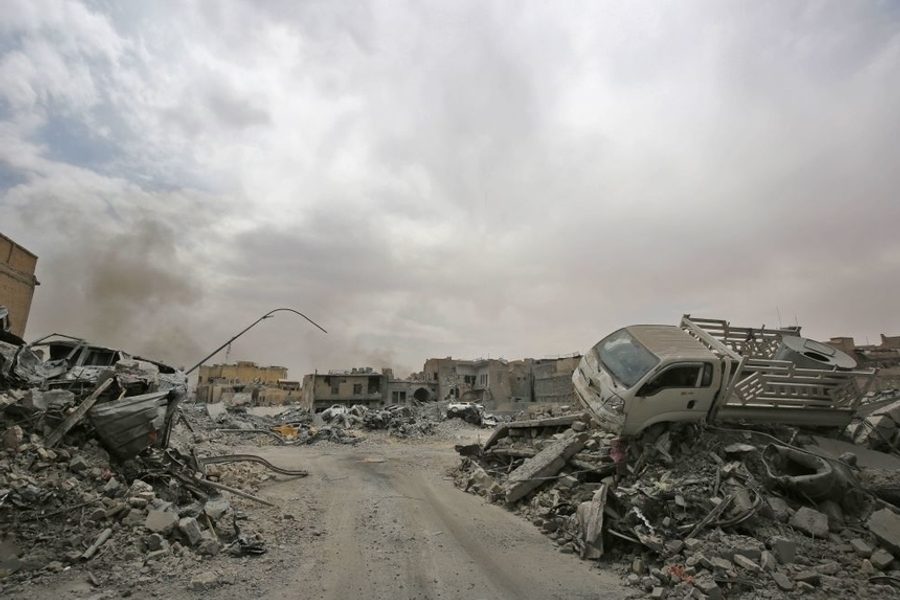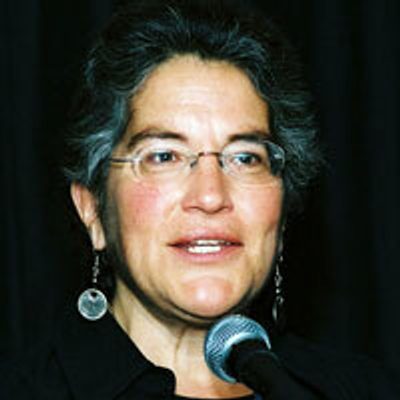Is This What “Liberation” Looks Like? U.S. Airstrikes Have Devastated Mosul.
ISIS may be on its way out, but the Iraqi city has a long road ahead.
Phyllis Bennis

ISIS’ occupation of Mosul, once Iraq’s second largest city, has virtually come to an end. Though small-scale fighting continues, and U.S. military strikes continued through at least July 17, ISIS control over the city has largely collapsed. Many among the ISIS forces were killed, many fled and many have probably melted back into local communities. U.S., Iraqi, and some other governments and media are celebrating the defeat of ISIS as the liberation of the city.
Certainly there is a great relief for the hundreds of thousands of residents who were driven out of their homes or who survived years of ISIS brutality, extremism and destitution. Certainly the end of ISIS control of its largest Iraqi population center is important in the struggle to reduce and eventually end the financing, military power and global appeal of the terrorist organization. The same is true of the likely military defeat of ISIS in Raqqa, its Syrian center and “capital” of its so-called caliphate.
But, as the New York Times vastly understated in an editorial last week, “the celebration should be brief.”
Who Pays the Price?
The price paid by the people of Mosul is incomprehensibly high. Thousands of civilians have been killed — no one knows exactly how many people have died, how many bodies remain crushed under the rubble of the once-vibrant city, how many whole families have been lost, how many children have been orphaned. A million or so were displaced from their homes; hundreds of thousands of weakened, malnourished Moslawis, many of them psychologically devastated from years under ISIS rule, are still languishing in ill-equipped camps in the desert outside the city, where temperatures routinely soar to 120 degrees.
No one can be sure yet of which military forces fighting in and around Mosul were responsible for exactly which civilian deaths. Certainly ISIS killed many people — directly and indirectly. There is little question, however, that the United States caused a major share of the carnage. On May 19 the Trump administration announced that its new tactic in both Mosul and Raqqa would be to surround and “annihilate” ISIS; this translated, as expected, into a cascading escalation of violence against the trapped civilian populations.
This tactic of “annihilation,” according to International Crisis Group’s longtime Middle East director Joost Hiltermann, could be related to the higher proportion of foreign militants among the remaining ISIS forces in Mosul as Iraqi ISIS fighters may have been able to simply melt back into local communities. And, according to Hiltermann, the Pentagon is especially concerned about these foreign militants: They believe , “the primary threat posed by surviving ISIS fighters derives from those who came from Europe and could return there to engage in acts of violence.”
Their assessment was likely based on the perceived threat those foreign fighters might pose to Americans as well as Europeans — while lacking any real concern about Iraqis. If, as is likely, foreign fighters are not the main problem, and ISIS is in fact an organization with what Hiltermann identifies as “primarily Syrian, and especially Iraqi roots and leadership,” then the annihilation tactic is a classic example of privileging U.S. and European lives at the expense of Arab lives. As Hiltermann points out, “eradicating ISIS fighters, with attendant high costs in civilian lives and destruction of civilian areas, would do little to eradicate the political sentiments that gave rise to ISIS in the first place, and pave the way for the rise of ISIS version 2.0 — possibly an even more virulent form.”
The Pentagon claims it has been responsible only for a total of 603 “accidental” civilian deaths since the entire anti-ISIS air war began back in 2014. But Airwars, a British-based organization that tracks civilian deaths from the air war in both Iraq and Syria, estimates that U.S. coalition airstrikes killed 529 to 744 civilians in June alone — about 52 percent more than in the month before.
And that air war has destroyed much of the city as well. While ISIS suicide truck bombs and explosive devices caused significant damage since its seizure of the city in 2014, it has been primarily the U.S. airstrikes of the last nine months or so that largely reduced west Mosul to rubble. According to Airwars’ report, in June the U.S. coalition fired roughly 4,100 munitions “in support of operations to liberate Mosul — a 21 percent rise from May. Those strikes were focused on an increasingly small number of neighborhoods, with Coalition officials confirming that Iraqi airstrikes in Mosul had ceased by June 20 or earlier. Most recent heavy destruction in the city from incoming strikes has therefore been a result of U.S. and allied actions.”
The infrastructure of the city, especially on the western side, is in ruins. The United Nations estimates it will cost over $1 billion just to stabilize Mosul with the most basic levels of repair to the electricity, water, and sanitation infrastructure and beginning to reopen schools and hospitals. Full rebuilding of the city will take billions more. Mosul — and potentially Raqqa in the not-too-distant future — is replicating the iconic role played by Ben Tre in Vietnam, where a U.S. major infamously asserted in 1968, “we had to destroy the village in order to save it.”
Into the future
Destroying the village — or in this case the city — will certainly not end terrorism, nor will it mean the end of ISIS. Despite — and at least partly because of — Washington’s almost 16 years of war against terror, terrorism is doing just fine. Military force doesn’t work against terrorism. In the last several years ISIS expanded from a vicious terrorist organization to include a conventional military force capable of seizing and holding territory and people. It’s that latter component that the current U.S.-led military coalition is able to challenge, and certainly diminishing or ending that conventional military capacity is important. It is primarily important for the hundreds of thousands of people forced to live under the extremist violence of ISIS, and the loss of a land-based caliphate will undermine at least some of ISIS’ ability to attract and recruit international supporters. For ISIS, the symbolism of losing Mosul also means the loss of the site where ISIS leader Abu Bakr al-Baghdadi first announced the creation of their so-called caliphate in 2014: Mosul’s historic al-Nuri Mosque lies in rubble.
But that is a far cry from ending ISIS, let alone ending terrorism. Because the range of strategies that have at least some chance of defeating terrorism — all of which are medium- to long-term, all of which involve political, diplomatic, humanitarian, economic and other approaches, and all of which require rejecting military options — are still marginalized, de-prioritized and under-funded.
The rebuilding of the shattered city is going to take a lot more than money. With around half the population still displaced, residents who barely survived the years of ISIS control and the months of fighting and airstrikes will need support for years to come. Many are injured or ill and will need extensive medical care, many children are malnourished. Many kids have been without school for long periods, and many others have grown up in ISIS-run schools shaped by militaristic, violent propaganda. Post-traumatic stress is almost certainly endemic throughout the population.
Beyond the physical and psychological, rebuilding any level of social cohesion remains an enormous challenge. The destruction of the city means that production, commerce and jobs are gone for an indefinite period, and there are no means of livelihood. There are divisions among survivors, with anger toward those perceived to have collaborated with ISIS reportedly leading to violence.
The costs will be enormous — and it remains uncertain where even a small part of that funding will come from.
The United States’ history regarding the rebuilding, or even assisting in the rebuilding, of cities and countries it has destroyed in war is a shameful pattern of abandonment and lack of accountability. The war is waged to consolidate a victory against a U.S.-identified bad guy, and the devastating impact on the local population is simply ignored, relegated to the sideline of “unfortunate collateral damage.” That pattern showed up powerfully across Iraq following the invasion and occupation of the country and following the bombing of critical infrastructure already weakened by a dozen years of crippling economic sanctions. For years, electricity beyond a couple of hours a day, and access to clean water, remained out of reach for most Iraqis. For many, those deprivations remain today. The pattern is already repeating itself in Mosul.
The Trump administration’s rejection of “nation building” extends far beyond a needed critique of past examples — Trump’s definition seems to imply an absolute refusal to provide any support for any of the people, cities, countries devastated by U.S. wars. United States funding for UN humanitarian agencies may be reduced to historic low numbers. And the capacity and willingness of the U.S.-backed Iraqi government to provide for the rebuilding of Mosul, let alone for the whole range of war-ravaged towns and cities across the country, remains in question.
For now, the Iraqi government is celebrating the end of ISIS control of Mosul. But it remains the same Shi’a-dominated sectarian government that in the years since the U.S. invasion and occupation began in 2003 has discriminated against and seriously oppressed Iraq’s large Sunni minority. This discrimination has diminished somewhat since the election of Haider al-Abadi, the current Iraqi prime minister, in 2014, but it remains a continuing problem. Shi’a sectarianism was one of the factors that led to the view among numerous Sunni Iraqis that as bad as ISIS was, it was somehow a lesser evil than the existing government.
It is clear that at least powerful figures in Iraq still harbor suspicions of Mosul’s people. According to the Middle East Institute’s Charles Lister, even before the final defeat of ISIS in the city, reports are surfacing from Mosul of “Iraqi security forces engaged in organized extrajudicial executions and torture, seemingly driven by sectarian revenge. Several leaked videos showed Iraqi forces throwing live men off a cliff, before riddling their bodies with automatic gunfire. The scene eerily resembled some of ISIS’ mass executions of 2014, in which Iraqi soldiers were executed and thrown into a river.” Human Rights Watch analysts reported similar atrocities after the Iraqi government’s claim that Mosul had been “liberated.”
Some in the military appear to hold the people of Mosul themselves responsible for the devastation ISIS wrought in the city. According to the Associated Press,
The people here have always had a rebellious nature, so they should take some responsibility for what has happened,” said Maj. Imad Hassan, a federal police officer from Baghdad. … “I hope this destruction teaches them their lesson,” he said.
That doesn’t bode well for Mosul being able to rely on support from the Iraqi government and military to protect and rebuild their city.
The question of how and by whom Mosul will be governed also remains uncertain. The U.S.-backed Shi’a-dominated Iraqi military now claiming credit for defeating ISIS are the same military forces who dropped their weapons and fled, leaving the largely Sunni civilian population of Mosul to face the violence of ISIS — and undoubtedly many Mosul residents still feel betrayed. Although not as dominant as the role of the Syrian Kurdish YPG fighters in Raqqa, the Iraqi Kurdish peshmerga forces from the semi-autonomous Iraqi Kurdistan played a major role in the military attack on Mosul over the last year. The Iraqi national government and the Kurdish regional authorities have already clashed over the question of the post-ISIS governance of Mosul, with Kurdish leaders hinting they might try to absorb the overwhelmingly Arab city into the Kurdish region. While Mosul is in northern Iraq, it has never been part of the recognized Kurdish region. But the fighting of recent years has upended many earlier assumptions.
What is required, but not yet on any official agenda, is the need to entirely re-think and reject the notion of “military solutions to terrorism.” There simply isn’t one.
A real solution to terrorism — not a fake military answer — requires something very different. And it won’t happen fast. What does that look like? It means creating a real negotiating process aimed at diplomatic rather than military solutions. It means pressuring U.S. allies Saudi Arabia, the UAE, Qatar and others to stop arming and financing ISIS and other extremist fighters directly or indirectly. It means pressuring the Iraqi government — by threatening to withhold the U.S. money, arms, training and diplomatic support it relies on to remain in power — to end its legacy of sectarianism. And to press other U.S. allies — including the Iraqi Kurdish regional government and others — toward negotiations rather than proxy wars in Iraq. It means beginning a conversation, even if the reality is far in the future, about the need for a real arms embargo on all sides. And it means a massive investment — of high-level attention, diplomatic expertise and, yes, huge amounts of money through the United Nations — into responding to the humanitarian disaster that is today’s Mosul.
But all of that remains in the future. For the moment, airstrikes and some fighting continue in the center of Mosul, though it appears all but certain that ISIS control of the city is ended. For the people who once lived there, rebuilding their lives seems very far away. The Associated Press reported one Mosul survivor’s view.
Hiyam Mohammed hid in her home with her family on the edge of the Old City throughout the fight. They could see the cemetery from their house.
“Some days the funerals lasted from dawn into the night. There were so many bodies piled up, it looked like a hill,” she said. “I thought I was going crazy seeing this. They didn’t even have time to wash the dead.”
She said the only way to justice is if the [Iraqi] government and [U.S.] coalition pay compensation to those who lost relatives or property.
“The government brought Daesh to us,” she said, referring to sectarian rule that fueled Sunni extremism and corruption that weakened the country’s security forces. “This mess is God’s revenge for that.”
Phyllis Bennis is a fellow of the Institute for Policy Studies and serves as international adviser for Jewish Voice for Peace. She is the author of the new book Understanding Palestine & Israel, from Interlink.








